Contemporary Images I The Plotters
and their End
To date (9/04) our research has uncovered two versions of
the famous group portrait of the plotters.
Both have been dated at 1605-the year of the plot.
The Hogenberg Group Portrait
The
Crispijn van de Passe the Elder Group Portrait
The two group portraits are quite similar. This is
also true to a certain extent of the portraits done of Percy by each
artist. Although it is tempting to conclude that the similarities relate
to the accuracy of portrait of the plotters the images are so much alike
that we must conclude that they are not independent and both artists must
have had some form of contact or relationship.
In The Gunpowder Plot The Narrative of Oswald Tesimond alias
Greenway., Translated by Francis Edwards,Published by The Folio
Society, London 1973. On page 6 the Hogenberg print is described in this
way: " The Conspirators and their Execution: German edition of an original
engraving by N. Visscher which appeared also in Dutch French and Latin
versions. Ashmolean Museum, Department of Western Arts: Folio Sutherland
77 (135)"
This attribution may be incorrect. Nicholas Visscher lived in the later
part of the 17th century and was the son of
VISSCHER,
CLAES JANSZ (Amsterdam, 1587 - 1652). Claes Visscher although Dutch did
travel to England and is well know for his engraving of London as well as
of famous persons of the time. There is some resemblance in the style.
We are interested in obtaining the source of the attribution to N.
Visscher. A complete name would also help.
The Hogenberg
Group Portrait
The image below has been credited in an Ebay auction to
Franz Hogenberg.
About Hogenberg- (b Mechelen, c. 1540; d Cologne, c.
1590). Painter, engraver, etcher and publisher, son of (1) Nicolas
Hogenberg. He was probably a pupil of the cartographer H. Terbruggen in
Mechelen but later worked in Antwerp, producing such engravings as the
Allegory with Fortune (1561; Hollstein, no. 39), the Battle between Lent
and Carnival (etching, 1558; published by Hieronymous Cock, H 40), the
Fools’ Dance (H 41), and a portrait of Mary I, Queen of England (1554; H
54). It was probably in Antwerp that he executed several maps for the
Theatrum orbis terrarum of Abraham Ortelius, which was published in 1570
(H 131). It is also possible that he travelled to Poitiers in 1560, as his
name and that date appear on an engraving by Joris Hoefnagel of the
‘Celtic Stone’ at Poitiers. A visit to England is suggested by the 1568
engraved portrait of William Cecil, Lord Burghley (1568; H 43). Also from
the period are the portraits of Robert Dudley, Earl of Leicester (H 45)
and Elizabeth, Queen of England (H 46); all three portraits were published
in the ‘Bishop’s Bible’ of Matthew Parker (1568). Hogenberg also engraved
two Views of the Royal Exchange in London (H 58, 59). Source-
http://www.artnet.com/library/03/0385/T038512.asp
First Franz and later his sons produced engravings
of contemporary events from 1560-1605.
Communication with the National Portrait Gallery, London
suggests that this is the same engraving as this one:
NPG D19881 The Gunpowder Plot Conspirators, 1605 (Thomas Bates; Robert
Winter; Christopher Wright; John Wright; Thomas Percy; Guy Fawkes; Robert
Catesby; Thomas Winter) by Unknown engraver Date: 1606 Medium: engraving
Measurements: 10 1/2 in. x 12 1/4 in. (266 mm x 312 mm) paper size Not on
displayNPG D19881 is not catalogued by Hind but another impression
in the British Museum is recorded in Freeman O'Donoghue's Catalogue of
Engraved British Portraits... in the British Museum, London 1908 (Group
portraits volume, p. 4, no. 4).
Derek Ward has kindly provided a translation of the German Text which
is found on either side of the group portrait:
A proverb said long ago
One crow flocks with another.
Such is what you see on this page
where a gang has come together
of English nobles
The instigator wasRobert Catesby,
the second Thomas Percy
both of noble family
so that they were called squires.
These brought still more into the game
though it was their own will
for where a person loves to dance there is good
piping and that makes people leap.
Robert Winter did not wish to be
the last,he brought with him
his brother into the hellish confederacy.
John and Christopher Wright
willingly and submissively joined
which cost them both their lives.
Robert Bates wished to be
to his master true which later cause him to rue.
The best man
was Guido Faukes who
undertook to light the fuse
that fire should then come after.
In this company Digby, Grant
Rockwoud, Keyes and others unnamed.
Their attempt was on
the king together with the whole House
of Parliament by means of gunpowder
deposited there: The plan went wrong
and the attempt come to light in a miraculous way
in a letter.
Several took to flight,
the others were seized by the collar
and put in prison,
afterwards put on trial.
Several were put on hurdles
and dragged out to the gallows,
a noose put round their necks,
made to bend at the gallows tree but cut down.
On a bench soon in the middle
their stomach opened up, their innards
thrown into a fire,
their godless hearts round the mouth
affixed and immediately
their heads hewn off and finally
the body divided in four pieces
which were hung here and there,
their heads put on a stake
and publicly exhibited
to the whole world to show
that such is the reviled reward,
so must it be for all others.
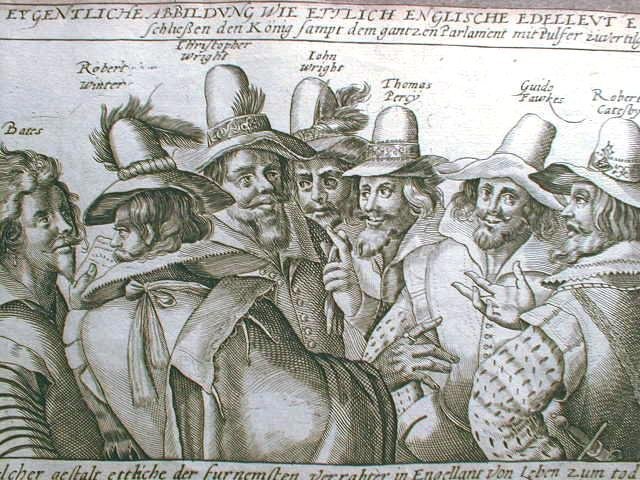
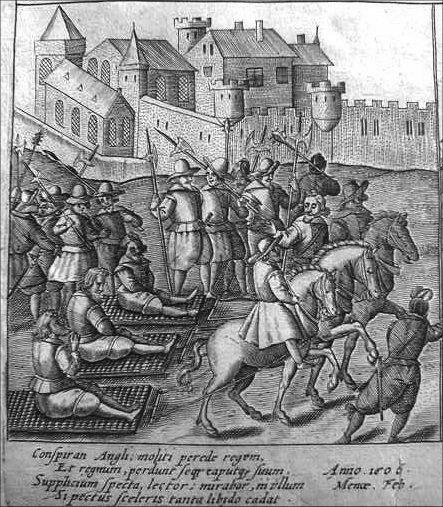
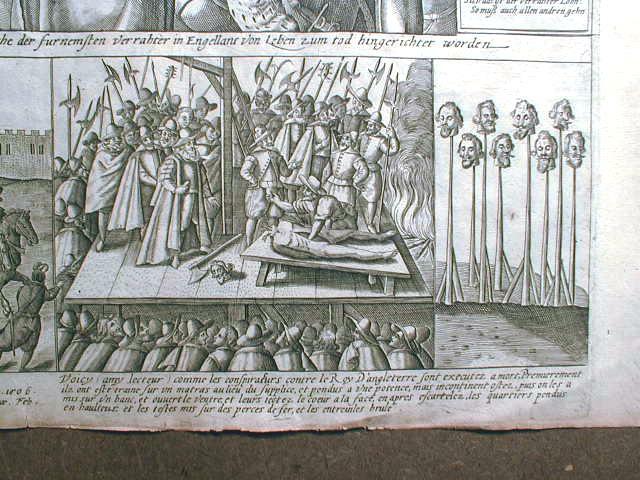
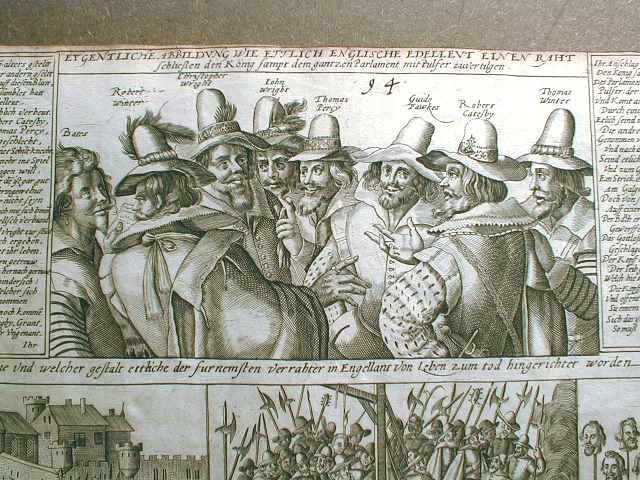
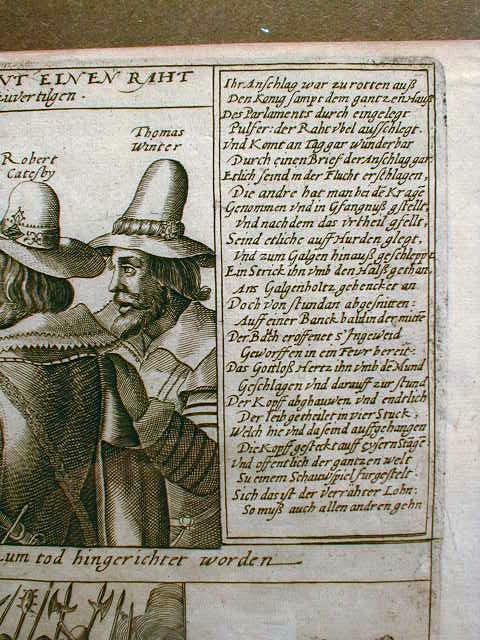
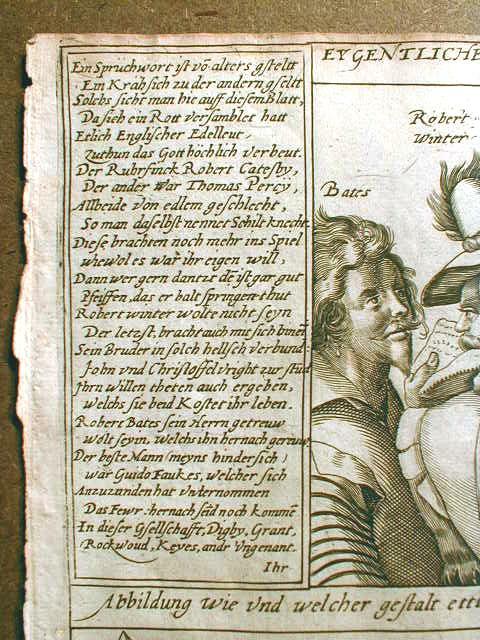
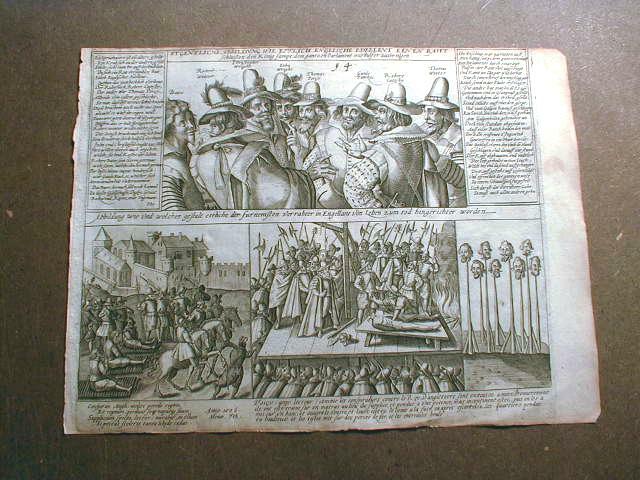
This image provides portraits of the conspirators
and documents their fate. They are shown
as gentlemen- real men though clearly they are
cast as brave outlaws full of plot and strength.
Their treatment is depicted as barbaric and the
crowd is clearly captivated by shock and is not
jeering. The men sit up as they are drawn through
the streets in defiance and we are again reminded
of the barbaric treatment as we are confronted
with heads on pikes. The text is in German and
hints at an artist interested in depicting
the scene accurately. This is perhaps the most famous
image of the plot.
In addition to being found in the collection of the National Portrait Gallery
it is in the collection of the Bodleian Library, Oxford
To return to
the top click here
The Crispijn
van de Passe the Elder Group Portrait
This engraving is found at the National Portrait Gallery, London and is
recorded as follows:
NPG 334a The Gunpowder Plot
Conspirators, 1605 (Thomas Bates; Robert Winter; Christopher Wright; John
Wright; Thomas Percy; Guy Fawkes; Robert Catesby; Thomas Winter) published
by Crispijn van de Passe the Elder engraving,circa 1605 On display at the
National Portrait Gallery NPG 334a NPG 334a
is the print catalogued in A.M. Hind's Engraving in England in the
Sixteenth and Seventeenth Centuries, Part II, The Reign of James I,
Cambridge, 1955, no. 64, pp. 391-2
.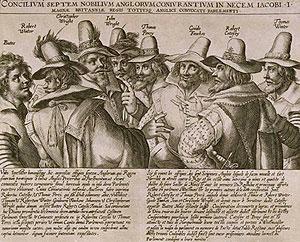
Then there is this one which turned up on the
internet....perhaps another version but very like the one above.
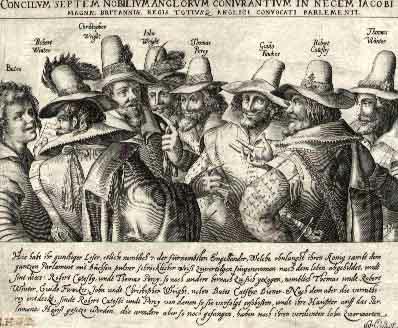
To return to the top click here
|








